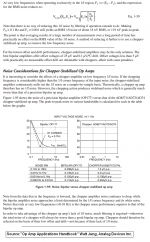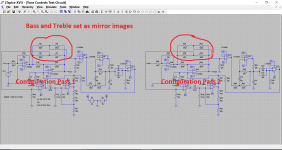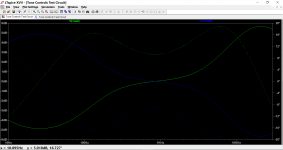Chris, before you start using such strong language, not sure if you followed the op amp listening test conducted in this thread. If not, it started with post #761 by Mooly, back on page 77. Under the conditions of that test, some people did hear some very small differences between op amps. The people who did hear differences included a few who previously made statements similar to yours.
Hardly conclusive though, it wasn't exactly a controlled experiment, the differences were small. It was interesting, enough to say worth further investigation, perhaps.
Oh, and Jay--add this one to your list. 🙂 http://web.mit.edu/6.101/www/reference/op_amps_everyone.pdf
But really, the application notes and guides from all the biggies are very very good learning resources. We're lucky to have them at our disposal.
Oh, thanks 🙂 For amplifiers, I like reading Self's book. Is there something like that for free? 😀 (*greedy*)
BTW, I think we computer guys are unique. We had to deal with rapid change in IT technology. There are so many programming languages and databases and hardware and standards... So we learn to be selective in what we learn and what we read...
The catch is perfect DC operation like everything thermally tied on one chip, their composite amps have too much 1/f & DC wander besides they're stuck at the .3nV or so region.
Scott, if one is interested on the noise and stability at very low frequencies close to DC, aren’t Chopper-stabilized amps a viable option?
I was reading from the link that rayma kindly provided http://www.kelm.ftn.uns.ac.rs/literatura/mpi/pdf/Op Amp Applications Handbook.pdf
George
Attachments
we computer guys are unique.
That's indeed the general impression.
Common engineers had to learn basic, fortran, (turbo) pascal. Then there was visual-c, which made one wonder wtf all those many hours of computer classes had been good for. I worked a weekend-night unix system manager job for several years, possibly one reason why I felt the urge to thoroughly beat up someone on a regular basis.
Last couple of weeks I had to explain to a 'computer guy' several times how and what I want the homepage of my website to look like.
Each time I talked to him, he felt the urge to quickly show me something while I spoke, by hitting his keyboard at a rate of 100wpm.
This morning, my main host told me on the phone that the homepage doesn't show because the joker hadn't made the domain public.
Software packages for building homepages are like visual basic/c++, it doesn't even require a brain to use them, I could have saved a lot of time by setting up my website myself.
YMMV
Jay: Try reading about Maurice Wilkes. He had to work out HOW to program computers. The history of LEO is fascinating as makes you realise how far they created modern computing. You will realise soon you are a gnat standing on the head of the giants and not unique at all. I bet you don't even have to fight big vs little endian problems on a daily basis!
Scott, if one is interested on the noise and stability at very low frequencies close to DC, aren’t Chopper-stabilized amps a viable option?
I was reading from the link that rayma kindly provided http://www.kelm.ftn.uns.ac.rs/literatura/mpi/pdf/Op Amp Applications Handbook.pdf
George
I think the problem here may still be noise George - great DC performance though.
Someone will probably crack this noise issue with a 'left of field' approach rather than the brute force one of paralleling numerous devices, or cooling etc. However, I suppose you could just wire bond a whole wafer of BF862's directly to create a massively parallel device and then cryogenically cool it to deal with the dissipation.
Trying to extract information at 10^-22 levels below ambient reference - well there's a challenge!
You will realise soon you are a gnat standing on the head of the giants and not unique at all.
"If we have not seen further, it's because we are standing in the foot prints of giants"
cheers, Gerhard
Common engineers had to learn basic, fortran, (turbo) pascal. Then there was visual-c, which made one wonder wtf all those many hours of computer classes had been good for. I worked a weekend-night unix system manager job for several years, possibly one reason why I felt the urge to thoroughly beat up someone on a regular basis.
YMMV
First, I learned BASICA at high school. Then learned (turbo) pascal, 8051, avr, pic assembly language, (delphi) pascal, visual basic, C, perl, and a forgot many things that I learned 😀
Sometime I mix-up the syntax of several language 😛
Although I can make a software, but a still love to design a electronic hardware, analog and digital. Am I computer guy? I don't think so. Am I unique? I think, so 😀
Mark, you have just been trolled by a 'student'.Chris, before you start using such strong language, not sure if you followed the op amp listening test conducted in this thread. If not, it started with post #761 by Mooly, back on page 77. Under the conditions of that test, some people did hear some very small differences between op amps. The people who did hear differences included a few who previously made statements similar to yours.
Over the past couple of days I have taken a brief closer listen to Mooly's Norah Jones test files on my work tractor sound system....rather better than what you might think.
I only bothered to listen to the first 10 seconds or so of each of the files, and I indeed find distinct differences in the files.
The lead in cymbal playing up to crescendo of the cymbal is distinctly different between the files, as is the following brushing sound, and so on.
If I can find time I will formally note what I find, but suffice to say, some files sound messy and wrong, and one at least sounded pretty good.
I have also put passed these wav files through my usb filter cable, and the differences are in this case more clearly defined and more obvious.
Is there agreement that Mooly's choice of opamps are equally suitable in the particular application example ???.
If not, please explain where any confounders to Mooly's experiment lie (Schematic please Mooly) and suggest schematic values changes to 'level the playing field'.
If this example selection of opamps are deemed to be equally suitable in the application example, it is reckless and uninformed folly to declare that 'all opamps sound the same'.
Dan.
Dan, I know the cymbals at that point sound different (at least slightly, maybe more to some). I said previously that was the section I used for my own comparison. Whether they are big or small differences to particular listeners doesn't matter at this point. They will probably always be small to old men with limited HF hearing. They will probably also start out as small and insignificant to people just learning to focus attention on the differences.
That being said, that people could hear any difference at all is significant step forward. If the tone of discussion is shifting from words like fantasy, to words like small, that's great. Small is enough to warrant further investigation with young people or others who still have good HF hearing. We would also probably want to identify other factors that might make the differences stand out more to some people, and probably that is doable.
Also, the waveforms, lined up to the individual samples, look a little different, when expanded out in Reaper. One other thing I noticed was that it looked like there was some small drift in the sample clock over the time of the recording, at least as evidenced by the wav files generated from the mp3s. That is, if I lined up the samples at the beginning of the song, some of the versions might have been out of alignment by one sample or so near the end of the track. If they were VBR mp3, that might explain it.
Anyway, let's not reignite any flaming arguments back and forth. Effort would be better expended investigating why the files sound different at all, why the nature of the differences seem on the verge of not being easily ABX testable (someone suggested that might be because they are small, but I suspect other factors might come out with more research, perhaps something similar to the known facial recognition difficulties for unfamiliar races of humans), and how easily young people with good HF hearing can learn how to identify the differences.
That being said, that people could hear any difference at all is significant step forward. If the tone of discussion is shifting from words like fantasy, to words like small, that's great. Small is enough to warrant further investigation with young people or others who still have good HF hearing. We would also probably want to identify other factors that might make the differences stand out more to some people, and probably that is doable.
Also, the waveforms, lined up to the individual samples, look a little different, when expanded out in Reaper. One other thing I noticed was that it looked like there was some small drift in the sample clock over the time of the recording, at least as evidenced by the wav files generated from the mp3s. That is, if I lined up the samples at the beginning of the song, some of the versions might have been out of alignment by one sample or so near the end of the track. If they were VBR mp3, that might explain it.
Anyway, let's not reignite any flaming arguments back and forth. Effort would be better expended investigating why the files sound different at all, why the nature of the differences seem on the verge of not being easily ABX testable (someone suggested that might be because they are small, but I suspect other factors might come out with more research, perhaps something similar to the known facial recognition difficulties for unfamiliar races of humans), and how easily young people with good HF hearing can learn how to identify the differences.
Last edited:
Sure, I read the list of opamp types, but I did not bother to remember any correlations..ie I don't consciously know or care for the code.That only shows that you deliver better guesses after you know who is who.
So far I have been listening using the 'Ethel' etc labels..ie I understand that there are five 'possible' sounds and I intend to write descriptions of the sounds of each of these 'mystery' labels.
Dan.
ADA4898-1: all the modern trappings on a SiGe BJT-input opamp. Pretty low noise to boot. 🙂
Sorry Dan I mis-spoke, the ADA4841 was what went into the mic the ADA4898 is the current 1nV general purpose amp on a more modern process. JC could try this, I don't do DBT listening so he can decide for himself.
This stuff is all done in CA these days.
Is there agreement that Mooly's choice of opamps are equally suitable in the particular application example ???.
If not, please explain where any confounders to Mooly's experiment lie (Schematic please Mooly) and suggest schematic values changes to 'level the playing field'.
This is the circuit and its response with the controls set to 'cut and boost' and then 'boost and cut'. The last shot is of the overall response of the two set ups, one after the other. The rise in HF looks alarming but look at the scale.
Attachments
Scott, if one is interested on the noise and stability at very low frequencies close to DC, aren’t Chopper-stabilized amps a viable option?
I was reading from the link that rayma kindly provided http://www.kelm.ftn.uns.ac.rs/literatura/mpi/pdf/Op Amp Applications Handbook.pdf
George
Yes, but I need to find out any issues with that route. They tried composite amps but they didn't work. I suspect something is missing from the equation. BTW not much commercial interest here (8 sockets total) this is purely for the enjoyment in helping out. FYI, the reason for this is that the beginning of the chirps are buried in noise and there is real information lost there.
Last edited:
Another thing I forgot to mention about the listening test comparison files: I went back and checked, and I downloaded the wav versions. Not sure what the mp3 versions sound like, don't know if any of the differences in the wav versions made it through the lossy mp3 encoding.
Jay: Try reading about Maurice Wilkes. He had to work out HOW to program computers. The history of LEO is fascinating as makes you realise how far they created modern computing. You will realise soon you are a gnat standing on the head of the giants and not unique at all.
Bill, please try to understand everything properly. If you have difficulty in understanding, you can assume, but do not assume that your assumption would always be correct...
I don't know (well of course I do) what you have in your mind when I said that computer guys are unique. But the points really were:
IT changes faster than other engineering fields. The consequence is that there are more to learn in IT. Consequence is that we need to develop a skill to choose the right item to study (Java or C, Eclipse or IntelliJ, ADempiere or Odoo, etc.) otherwise we don't have time to master anything we learn, or what we learn might be obsolete, etc...
I think because of the above situation, I value high quality books or reference (such as the Feynman lecture for Physics suggested by SY). I like to have a good reference book for everything that I learn. I don't like reading random books or read books of similar contents, or "derivatives" of the original source. I glanced over the TI book regarding opamp, and also read a few from the AD book (Walt Jung) and I decided that for OPAMP, I will only read the AD and not the TI...
So my ramblings regarding IT and its uniqueness do have correlation to the topic or post I was replying. What I found unrelated is the Maurice Wilkes and being a gnat standing on giant's head...
Without Maurice and his contemporaries you would not have a job... think about it.
IT doesn't change very fast these days.
Java: 21 years old
C: around 46 years old
Eclipse 15 years old
And new cobol is still being written every day.
IT doesn't change very fast these days.
Java: 21 years old
C: around 46 years old
Eclipse 15 years old
And new cobol is still being written every day.
Bill, IT changes fast for the average IT guy. Yes, C is still around, but MS seems to be writing everything in C# now. Or they were last week anyway.
- Status
- Not open for further replies.
- Home
- General Interest
- Everything Else
- What is wrong with op-amps?



